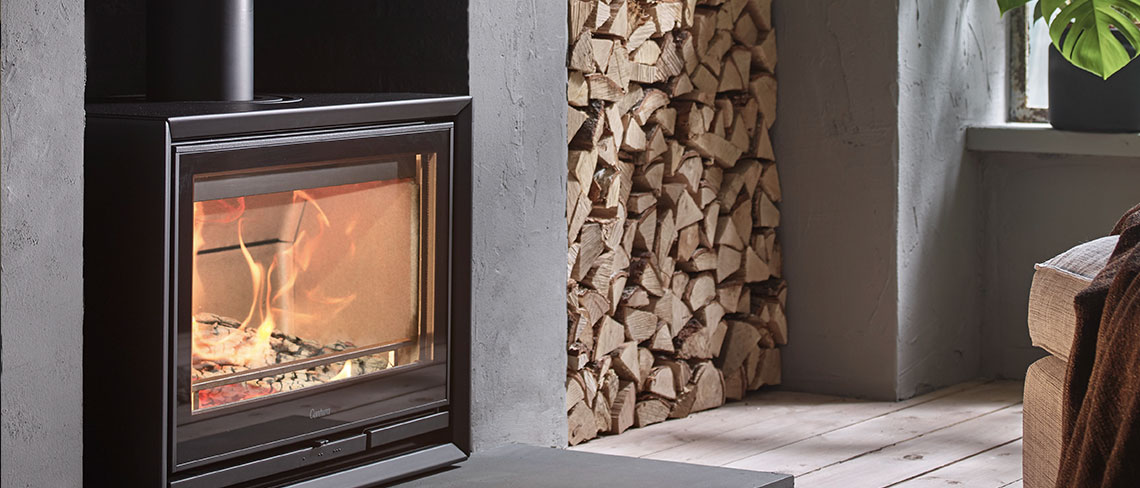
Contura tips to achieve cost-effective, safe and conscience-driven Cosyology this autumn-winter.
As the colder temperatures set in, many of us will be looking for ways to keep cosy.
There are few things in life more comforting and mesmerising than the long, lazy flames and crackling sound of a freshly lit wood fire, however, there is some confusion around the impact of wood burning stoves on the environment and the efficiency of firewood as a fuel source.
Contrary to popular opinion, when used and maintained correctly, a wood burner can provide an efficient, cost effective and sustainable domestic heating solution. Likewise, firewood is a highly efficient and low-carbon energy source.
By understanding and following best practice and making the right choices when it comes to wood fuel, homeowners can ensure the best possible performance from their appliance.
In this comprehensive guide to firewood, the aptly named Phil Wood of Swedish wood burning stove manufacturer, Contura, provides important tips to help minimise emissions, ensure an efficient burn, and dispels some of the common misconceptions surrounding the use of wood vs. fossil fuels.
Phil says: “With rising gas and electricity prices it is understandable that many are concerned about how to heat their homes as we head towards winter.
“Whilst open fires are not ideal due to the inefficiency of burning wood without regulating airflow and due to the contaminants they release into the air both into and outside the home, wood burners that meet government regulations are an effective, safe and environmentally viable home heating option and will help save on gas bills.”
Read on for Phil’s guide to firewood…
The cost
“Priced at an average of 4p per kWh (kilowatt hour) compared to 14.37p per kWh for electricity, burning wood is the more cost-effective option for heating.
“Gas is charged at an average rate of 24p per day and is typically 3.8p per kWh. Although this is 0.2 pence cheaper than a wood burner, it’s worth bearing in mind that gas and electricity rates are set separately by providers and are subject to increases, whereas wood costs are not subject to these ad hoc rises.”
A low-carbon, renewable fuel
“Unlike coal or natural gas, wood is a low-carbon fuel. This means that burning wood results in a relatively small net release of carbon dioxide into the atmosphere, which is then re-absorbed when new trees grow, effectively balancing out the combustion of bioenergy.
“Switching from smokeless or mineral fuels to wood will ensure a reduction in carbon emissions.
“Wood is also renewable, whilst fossil fuels such as coal, crude oil and natural gas aren’t. A renewable resource is defined as a natural resource which will replenish to replace the portion depleted by usage.
“When a tree is cut for fuel it will naturally be replaced by a younger tree that springs up in its place. It’s also important to consider, however, the concept of sustainable forest management – both locally and worldwide. Most firewood is collected as a result of thinning the forest (coppicing) to provide space, nutrition and light for thicker, more established trees to prosper. So opting for local coppiced wood benefits woodlands, prevents waste, and also helps to ensure ‘low fuel miles’ as wood is transported to areas nearby – within a 30 to 100 mile radius – rather than sourced from forests abroad.”
Maximising efficiency
“Just two logs per hour are required to keep a wood burner going, whilst in an open fire, for example, you’ll need eight logs for one hour.
“Similarly, a wood burning stove is 60% more efficient at heating the home as heat transfer is convected into the room, rather than being lost up the chimney in the case of conventional open fireplaces.
“For anyone that does not necessarily want to heat all spaces at all times, local space heating using firewood is an extremely efficient heating solution, however, many customers tell us that a single wood burner provides enough heat to warm their entire property. This is particularly important in rural areas, where mains gas supply isn’t always available.”
Minimising emissions
“Wood burning can be an environmentally viable heating solution if practised in the correct way.
“Ecodesign stoves have been engineered to burn wood more completely. The targeted introduction of combustion air at higher levels in the fire box of the stoves reignites the combustion particles before they can leave the stove. This technology reduces particulate emissions by 90 percent compared to an open fire or 80 percent compared to a stove of 5-10 years old and can also lead to significant reductions in Carbon Monoxide, Nitrous Oxides and Organic Gaseous Carbon compounds (OGCs).
“If you have an open fireplace or an out-of-date wood burner, consider replacing it with a wood burning stove that meets the Ecodesign regulations. To optimise efficiency, it is important to choose a size of stove to suit the room size you want to heat.
“The stove should be cleaned out regularly to remove excess ash, soot and debris, as this will ensure a more efficient burn and minimise smoke. Get your stove serviced by a professional chimney sweep once a year, as this will troubleshoot any issues and ensure the stove is working at its best year-round.
“To minimise emissions, it is also crucial that you burn the right fuel, learn to light the fire correctly and refuel the stove at the right time…”
Sourcing firewood
“Using firewood contributes to fuel independence as it can nearly always be sourced locally, within a 30-100-mile radius, which means it extremely efficient in fuel miles terms and those purchasing firewood are also supporting the local economy.
“Aim to buy the best quality seasoned, dry or kiln-dried wood you can afford from an accredited supplier. The UK’s wood fuel accreditation scheme, Woodsure, issues a ‘Ready to Burn’ certification mark to wood suppliers that can demonstrate that their logs have an optimum moisture content between 12 and 20 percent. This will both minimise emissions and also ensure maximum efficiency from your wood-burning stove.
“Never burn wet, green or treated (polished, varnished or oiled) or mixed waste wood products such as pallets, furniture, fencing, plywood, MDF or building materials such as Oriented Strand Board, as these will give off nasty fumes, can damage the stove flue and will produce a lot of smoke.
“Avoid soft woods such as pine, firs and cypress, which burn too quickly and produce more smoke. Instead, opt for good quality hardwood species such as ash, oak, beech or birch as these will burn the cleanest and longest with a bright flame.
“And as mentioned previously, it’s important to buy firewood from a company that employs sustainable forest management practises such as coppicing.”
Storing and stacking firewood
“Properly stacking firewood is the only way to ensure airflow to keep your logs dry.
“A dedicated rack or wood store is a popular way to store wood outside as it ensures logs are elevated from damp ground and allows for airflow. Most come with rooftops to protect from the elements but the front and/or sides should be open to allow air to circulate.
“In lieu of a dedicated log store, using a pallet to keep the wood elevated to ensure airflow is a sensible option.
“Keeping firewood aired through as much as possible is vital to achieving optimum moisture content. Whilst this is important for all wood, it’s even more crucial for logs you’ve cut yourself (green wood), which must be allowed to continue to dry, but seasoned wood also fares better when able to breathe. As a rough rule of thumb, green wood takes between 6 and 18 months to become fully seasoned and ready to burn depending on the species. Burning before it’s fully seasoned will result in more smoke and a far less efficient burn. Indicators of the moisture content being at the right level are when the bark starts to lift a little and the ends of the logs start cracking. A moisture meter can confirm this; less than 20% is optimum.
“It’s also important to remember that split logs dry better than full rounds.
“The key rule for indoor stacking is to make sure your wood is at a safe distance (at least half a metre) from the wood burner. Although it looks pretty piled up next to the stove it is incredibly dangerous as the heat transfer from the stove could easily set the logs alight.
“Log storage units made from wicker, rattan, felt and leather can work well and are also useful when it comes to transporting wood from outside. Ready-to-burn logs available in bags don’t take up a lot of space.”
“If you’re unwavering about displaying firewood right next to the stove, there are models (like the Contura 300 series, for example) that incorporate log boxes that are specifically designed to isolate the heat.”
Best practise burning
“To use a wood burner correctly, you need to warm the stove and chimney chamber through first, rather than trying to create a roaring fire and a lot of heat straight away. It’s better to build the fire up progressively. Think of lighting the stove as a similar process to pre-heating an oven, which needs time to warm up properly before it cooks efficiently. A roaring fire is more often the result of loading too many logs in one go. You shouldn’t overload the space but use it as efficiently as possible. As a rule, a wood burner requires 2-3 logs per hour.
“Most of us are familiar with putting kindling at the bottom of the fire, but this makes it more difficult for the fire to get going at the start, leading to an inefficient burn and more smoke.
“The lesser-known practice of ‘top-down lighting’ (placing kindling at the top) is far better for warming the flue and for the environment as it causes less pollution and fewer emissions. The kindling will catch more slowly, as it’s at the top of the fire, and it will also generate less smoke. Lighting the kindling in this way is therefore more environmentally friendly.
“To try the ‘top-down lighting’ technique – start with two logs of approximately 7-9cm width, 20-30cm length. Add 3-4 layers of kindling, approximately 2-3cm wide, building upwards in a criss-cross formation. Maintain a good air gap between logs and kindling for air circulation. Add 1-2 natural firelighters to the top of the kindling and light them. After 30-40 minutes, when the fire has burnt down to glowing embers, it’s time to refuel.
“Remember that not all stoves are the same and that it’s important to always follow the lighting instructions in your product manual for instructions specific to your wood burner. This guide will also advise you about adjusting the air vents to maintain the correct air flow and combustion temperature.”
Refueling
“To ensure no smoke escapes into the living space, refuelling should only be done once the fire has burnt right down to glowing red embers and no yellow flame is present in the firebox.
“The door should be opened ajar slowly, allowing the firebox to pressurise a little with the incoming air flow, before opening fully to load more fuel; usually 1-2 logs.
“Open the airflow to ensure the fresh load of fuel catches quickly and efficiently and then slowly lessen airflow to increase the burn time of the fuel.”
For more information, visit www.contura.eu
-Ends-
Notes to Editors:
- Rooster PR will coordinate comment, interview and profile opportunities for Contura UK Country Manager, Phil Wood.
- The Contura PR team will also arrange visits to the nearest Contura Design Centre dealerships or the Contura showroom in Doncaster to see the product range.
For further press information, please contact:
Anna Nyman | Elsa Findlay | Julie Aguilera
Rooster PR
T: +44 (0)203 440 8930
E: [email protected]
About Contura:
Contura is Europe’s leading manufacturer of wood burning stoves, offering an extensive range of classic and contemporary wood burners; from traditional insert stoves suitable for existing fireplaces, to freestanding statement models made with innovative materials such as soapstone.
Starting at £1,395, Contura stoves are premium yet affordable. Award winning, timeless Swedish design means the products complement or enhance any style of home, whilst also offering outstanding performance, maximum efficiency, practicality and ease of use.
Designed and assembled at the factory located in Markaryd, Sweden, and manufactured to the highest standards, Contura stoves are highly energy efficient, offering powerful convection, superior combustion technology and clean burning systems. All Contura stoves are DEFRA Clean Air Act exempt and thus approved for use in Smoke Control Areas.
Contura stoves can be purchased through a network of 165 independent retailers nationwide.
Contura is part of the NIBE group, a Swedish manufacturing company producing world class solutions in sustainable energy across Europe, North America, Asia and Australia.
Contura is a founding member of the Stove Industry Alliance (SIA) in the UK.
For more information please visit www.contura.eu






